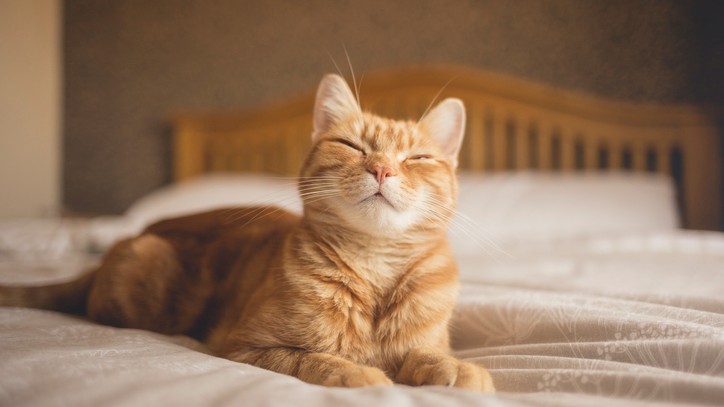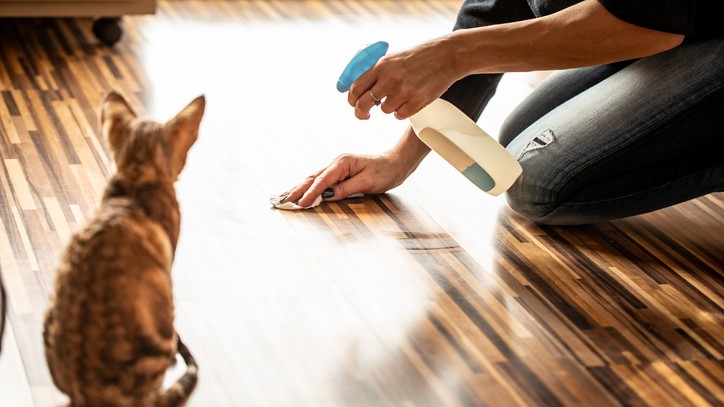Why does my cat pee on the bed? (And how can I stop it?)
Finding cat pee on the bed, or anywhere outside of the litter box, is a frustrating problem. But there are solutions, read on to learn more

Unexpectedly finding cat pee on the bed is every cat owner’s worst nightmare. Just as you crawl under your sheets at night, ready to relax, you find that your cat has used your bed as a litter box and you need to change all of your bedding before you can go to sleep! Fortunately, there are a number of things that you can do to address this behavior and help your cat return to normal litter box usage.
- How to litter train a kitten: A vet's guide
- Litter-robot III open air automatic self-cleaning litter box review
- PetSafe ScoopFree Ultra Self Cleaning Cat Litter Box review
- Modkat Flip Litter Box review
Work with your veterinarian to rule out medical conditions
If your cat is urinating outside of the litter box, contact your veterinarian. There are a number of medical conditions that can cause urinary changes, so it’s important to rule out these conditions as soon as possible. Your veterinarian will first discuss your cat’s urinary habits and perform a thorough physical exam. Next, they may recommend a urinalysis, blood tests, and/or radiographs (X-rays) to assess your cat’s urinary health.
Medical conditions that may be associated with abnormal urination include:
- Urinary tract infections in cats
- Urinary crystals and bladder stones
- Feline idiopathic cystitis (inflammation of the bladder)
- Arthritis, which may interfere with the ability to enter and exit the litter box
- Medical conditions that lead to increased urine output, such as diabetes mellitus, hyperthyroidism, and chronic kidney disease
With a full medical workup, your veterinarian should be able to definitively determine whether your cat’s urinary changes are medical or behavioral in nature.
Is it marking or inappropriate elimination?
In general, urinating outside the litter box can be broken down into two broad categories: marking and inappropriate elimination. Each of these issues is managed differently, making it valuable to determine which issue you are dealing with.
Marking involves depositing small amounts of urine (and, less commonly, feces) on socially significant areas. Marking typically involves vertical surfaces, although it can occasionally involve horizontal surfaces. In general, cats that are marking still use their litter box the majority of the time, but you are also finding small amounts of urine in other locations.
Inappropriate elimination, in contrast, involves a full or partial refusal to use the litter box. Cats may continue to defecate in the litter box but prefer to urinate outside the litter box, or vice versa. These cats deposit large amounts of urine when they urinate, fully emptying their bladder instead of the small volumes associated with marking. Additionally, inappropriate elimination almost always occurs on horizontal surfaces. If you are no longer needing to scoop the litter box as often and you are finding large puddles of urine, you are probably dealing with inappropriate elimination.
By looking at your cat’s litter box habits, location preferences, and the volume of urine they are depositing, it is usually relatively easy to distinguish between marking and inappropriate elimination. In general, inappropriate elimination is more common than marking.
How to handle inappropriate elimination
If your cat’s urinary habits are consistent with inappropriate elimination, the next step is to delve into the potential cause. In general, these cats have found an elimination spot that they find preferable to the litter box. This may occur for one of two reasons: either they love the new spot they have found, or they hate something about their current litter box setup.
To overcome inappropriate elimination, your goal is to make your cat’s litter box her desired elimination spot once again. This involves making the litter box as appealing as possible, while simultaneously making other locations unappealing for elimination.
Begin by purchasing a new litter box, which will be free of odors and negative associations. Be sure that this litter box is spacious and easy to use; an extra-large litter box or even an under-bed storage container is ideal. If you have multiple cats, you should have one more litter box than there are cats in your home; for example, if you have three pet cats, you should have four litter boxes in different locations throughout your home.
Next, experiment to find the best cat litter. Many cats have a distinct litter preference and are hesitant to use other litter types. An unscented clumping litter with a fine to medium texture is the most popular option, but individual preferences vary. Consider offering your cat a litter buffet, in which you set up multiple litter boxes, each filled with a different type of litter. After a couple of days, you should have a good idea of which litter your cat prefers, based on which littler she is using most frequently.
Be sure that the litter box is kept clean. Like humans, cats don’t enjoy using a dirty bathroom! Litter should be scooped at least once daily. Additionally, the entire litter box should be emptied and scrubbed (using soap) every 2-3 weeks.
Finally, make your cat’s other preferred elimination spots inaccessible or less appealing. Clean soiled areas thoroughly, using an enzymatic cleaner. Close doors to keep your cat out of certain areas of the home. If necessary, use sheets of aluminum foil or plastic carpet runners (placed “nubby” side up) to make areas of your flooring or furniture less appealing.

How to address urine marking
Unfortunately, urine marking can be more challenging. There are many potential underlying causes of marking, including sexual hormones, stress, and territorial behavior.
If your cat is not already spayed or neutered, that is the first step in eliminating marking behavior. Urine marking is more common in intact cats than in spayed or neutered cats.
Clean all marked areas thoroughly, using an enzymatic cleaner. Cats tend to return to soiled areas repeatedly, so cleaning can help prevent further marking. Additionally, block your cat’s access to marked areas if possible.
Next, encourage your cat to mark in other ways. Feliway Classic is a pheromone product that is often used for stress control in cats. This product contains low levels of the pheromones released in bunting, when cats rub their cheeks against objects to scent-mark them. By using Feliway Classic in your home, you may encourage your cat to try bunting instead of urine marking. Scratching posts can also help encourage scratching behavior as an outlet for marking.
In some cases, cats mark in response to animals they see outside. The presence of an outdoor cat may trigger your indoor cat to want to mark her territory. If this seems to be the case, block your cat’s access to doors and windows that allow her to see the outside world.
Stay calm and work with your veterinarian
Finding cat pee on the bed is certainly a frustrating situation. Don’t panic, though, and instead act rationally. First, take your cat to the veterinarian to ensure there isn’t a medical cause for her urinary issues. Next, consider whether the behavior is more likely to be urine marking or inappropriate elimination. Base your interventions on which behavior you feel is the more likely underlying cause. Finally, if your cat’s bad urinary behaviors continue, return to your veterinarian. Your veterinarian can help you with additional resources for modifying your cat’s behavior and environment, medication (if appropriate), and referral to a veterinary behaviorist or qualified trainer (if necessary).
PetsRadar Newsletter
Get the best advice, tips and top tech for your beloved Pets
Dr. Barnette is a graduate of the University of Florida, where she received both her B.S. in Zoology and her Doctor of Veterinary Medicine (DVM). She has 15 years of clinical experience as a small animal veterinarian, treating dogs, cats, and occasional exotic patients. She now works as a freelance veterinary writer, creating educational content for veterinarians, veterinary team members, and dedicated pet owners. Dr. Barnette lives in southwest Florida with her husband and daughter (plus two cats, a dog, and a rescued dove!) and enjoys kayaking, biking, and hiking. Learn more about Dr. Barnette at www.linkedin.com/in/catherinebarnette.

